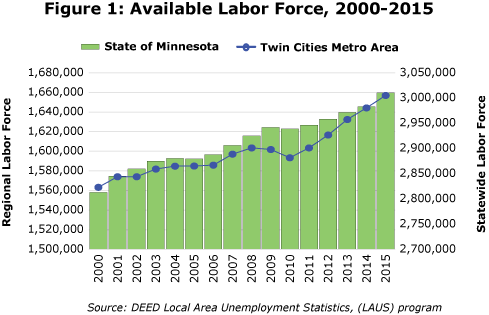
by Tim O'Neill
June 2016
The booming Twin Cities economy means the region must find a way to bring more minorities and people with disabilities into the workforce.
The seven-county Twin Cities metro surpassed 3 million people for the first time last year, according to U.S. Census Bureau figures. The region witnessed an increase of nearly 26,300 people between July 1, 2014, and July 1, 2015, accounting for over 80 percent of the state's population growth in the past year. Fifty-five percent of the state's population now lives in the Twin Cities.
Hennepin County, with an increase of over 11,000 people, and Ramsey County, with an increase of 4,500 people, added more people than any other Minnesota county in 2015. Dakota, Anoka and Washington counties each added about 2,500 people, rounding out the state's top five counties in terms of population growth in 2015.
Scott and Carver counties ranked ninth and 11th, respectively, for number of people added last year. Scott and Carver also were the state's second- and third-fastest-growing counties, respectively.
With population growing in the Twin Cities metro, it follows that the region's labor force would grow, too. Ignoring a small setback during the Great Recession between 2008 and 2010, the Twin Cities labor force has expanded steadily since the turn of the century, increasing by more than 93,650 people. In the last five years, the growth has only accelerated.
Between 2000 and 2010, the region's labor force grew by 30,000 workers, an increase of 1.9 percent. However, over the second half of that period, which included the recession, the labor force grew by just 8,339 people or 0.5 percent.
More recently, between 2010 and 2015, the labor force exploded by 63,565 workers, up 4 percent (see Figure 1).

Many of these new labor force entrants have quickly found jobs, while unemployment has plummeted. In fact, the Twin Cities' annual unemployment rate in 2015 was the lowest the region has seen since 2000. At 3.3 percent, the current unemployment rate represents about 55,400 people looking for work. Though this sounds like a lot of extra workers, it is less than half of the nearly 120,000 unemployed people in the region during the height of the recession in 2009. This has led to a very tight labor market for Twin Cities employers, who also absorb tens of thousands of workers who commute from surrounding regions like Central and Southeast.
While DEED's Local Area Unemployment Statistics (LAUS) data are the source for these monthly and annual labor force updates, the recently released 2010 to 2014 American Community Survey (ACS) five-year estimates offer unique insight into labor force demographics that are not available in LAUS. Breaking the data down by demographic characteristics reveals a much more complex picture of employment and unemployment in the region.
The Twin Cities has the highest labor force participation rate of the six regions in the state at 72.3 percent, which is also higher than the state's 70.1 percent rate. This includes higher participation rates in all but the youngest and oldest age groups. While 16 to 19 year olds have much lower labor force participation rates coupled with much higher unemployment rates, these figures improve significantly for those between the ages of 20 and 24, and again for those between the ages of 25 and 44. At the other end of the spectrum, participation rates plummet for people ages 65 years and older, even as unemployment among this group is very low (see Table 1).
Just over 1.1 million workers in the Twin Cities are between the ages of 25 and 54, accounting for 67 percent of the total regional workforce. This group is often considered to be in its "prime working years" since more than 88 percent participate in the labor force.
Although younger on average than workers elsewhere in the state, the Twin Cities labor force is aging. The number of workers ages 55 to 64 expanded by 23.9 percent over the past five years. Those 65 to 74 jumped by 27.5 percent, while those 75 and over grew by 7 percent. No other age cohort expanded by more than 2 percent during that period.
Though still skewed by the recession, the ACS data also provide insights on employment by race and ethnicity. The Twin Cities is the most racially diverse region in the state, home to over three-fourths of the state's minority workers, including over 85 percent of black and Asian workers.
Making up 82.2 percent of the region's labor force, the white alone population had the lowest unemployment rate by race. Unemployment rates were nearly three times higher for blacks and American Indians, and over twice as high for those reporting "some other race" or "two or more races."
Hispanics and Asians also had higher unemployment rates than whites, at 9.2 percent and 7.5 percent, respectively. Minority workers in the Twin Cities had high labor force participation rates, indicating a willingness to work despite barriers to finding a job (see Table 1).
| Twin Cities Metro Employment Characteristics, 2014 | |||||
|---|---|---|---|---|---|
| Twin Cities Metro | Minnesota | ||||
| - | In Labor Force | Labor Force Participation Rate | Unemployment Rate | Labor Force Participation Rate | Unemployment Rate |
| Total Labor Force | 1,659,285 | 72.3% | 6.8% | 70.1% | 6.5% |
| Employment Characteristics by Age Group | |||||
| 16 to 19 years | 72,733 | 47.4% | 21.3% | 51.1% | 18.7% |
| 20 to 24 years | 155,177 | 82.1% | 11.1% | 81.8% | 10.2% |
| 25 to 44 years | 732,608 | 88.5% | 5.7% | 88.1% | 5.8% |
| 45 to 54 years | 379,354 | 87.3% | 5.4% | 87.3% | 5.0% |
| 55 to 64 years | 257,416 | 72.8% | 5.6% | 71.8% | 4.9% |
| 65 to 74 years | 52,556 | 28.2% | 4.2% | 26.6% | 4.1% |
| 75 years and over | 8,720 | 5.8% | 3.5% | 5.9% | 3.5% |
| Employment Characteristics by Race and Hispanic Origin | |||||
| White Alone | 1,364,166 | 72.7% | 5.5% | 70.2% | 5.6% |
| Black or African American | 120,969 | 69.5% | 16.2% | 68.0% | 16.4% |
| American Indian | 8,052 | 60.9% | 15.7% | 59.4% | 17.4% |
| Asian or Other Pacific Islanders | 146,467 | 70.4% | 7.5% | 70.6% | 7.2% |
| Some Other Race | 29,734 | 77.5% | 10.7% | 76.2% | 11.0% |
| Two or More Races | 32,344 | 71.6% | 13.5% | 69.5% | 13.2% |
| Hispanic or Latino | 86,816 | 77.0% | 9.2% | 75.0% | 10.1% |
| Employment Characteristics by Disability | |||||
| With Any Disability | 70,444 | 50.8% | 15.6% | 51.0% | 14.0% |
| Source: 2010-2014 American Community Survey, 5-Year Estimates | |||||
Workers with disabilities were another group facing obstacles in the metro job market, with an unemployment rate above 15 percent and a labor force participation rate around 50 percent.
Addressing these unemployment disparities has become a necessity in the Twin Cities, especially as minority populations have witnessed the fastest population growth in recent years, a trend that is expected to continue. Bringing the unemployment rate for minority workers in line with the white rate would fill over 23,000 jobs in the region, while cutting the unemployment rate for workers with disabilities in half would contribute over 5,500 jobs.
Applying current labor force participation rates to the Minnesota State Demographic Center's population projections for the Twin Cities creates labor force projections for the next decade. While this method does not account for future labor force fluctuations or changing commuting patterns, it does provide an approximate idea of what to expect with the region's future labor force.
With the drastic shift toward an older population, Twin Cities labor force growth is projected to slow over the next decade. As Figure 1 shows, the region's labor force expanded by nearly 72,000 workers between 2005 and 2015, or an average of 0.5 percent growth per year. Over the next decade, the region's labor force is anticipated to expand by roughly 20,000 people. This equates to an average growth rate of just 0.1 percent per year (see Table 2).
| Twin Cities Metro Labor Force Projections, 2015-2025 | ||||
|---|---|---|---|---|
| Age | 2015 Labor Force | 2025 Labor Force Projection | 2015-2025 Change | |
| Numeric | Percent | |||
| 16 to 19 years | 77,806 | 76,427 | -1,379 | -1.8% |
| 20 to 24 years | 152,537 | 159,874 | +7,337 | +4.8% |
| 25 to 44 years | 689,008 | 670,693 | -18,315 | -2.7% |
| 45 to 54 years | 371,909 | 330,943 | -40,966 | -11.0% |
| 55 to 64 years | 277,603 | 303,780 | +26,176 | +9.4% |
| 65 to 74 years | 63,304 | 104,666 | +41,362 | +65.3% |
| 75 years and over | 9,500 | 15,670 | +6,169 | +64.9% |
| Total Labor Force | 1,641,667 | 1,662,053 | +20,386 | +1.2% |
| Source: Minnesota State Demographic Center | ||||
Despite the recent milestone of surpassing 3 million people for the first time, the Twin Cities will still feel the effects of an aging population and slower anticipated labor force growth.
Zooming in, numerous industry sectors may begin to feel these changes more quickly and severely than others. Transportation and warehousing, for instance, has a workforce where nearly three in 10 workers are 55 years of age or older.
Manufacturing, educational services, public administration and agriculture have older workforces as well, with more than a quarter of workers age 55 and over (see Table 3).
| Twin Cities Metro Workforce by Industry, Second Quarter 2015 | |||
|---|---|---|---|
| - | Total Workers | Jobs Held by Workers 55 Years and Over | |
| Number | Number | Percent | |
| Total, All Industries | 1,696,389 | 362,605 | 21.4% |
| Health Care and Social Assistance | 250,805 | 53,521 | 21.3% |
| Manufacturing | 169,375 | 42,922 | 25.3% |
| Educational Services | 150,718 | 40,983 | 27.2% |
| Retail Trade | 153,156 | 29,956 | 19.6% |
| Professional and Technical Services | 120,970 | 23,592 | 19.5% |
| Finance and Insurance | 106,715 | 21,352 | 20.0% |
| Wholesale Trade | 91,053 | 21,188 | 23.3% |
| Admin. Support and Waste Mgmt. | 98,544 | 19,441 | 19.7% |
| Public Administration | 66,267 | 17,608 | 26.6% |
| Management of Companies | 82,557 | 16,827 | 20.4% |
| Accommodation and Food Services | 130,673 | 15,802 | 12.1% |
| Transportation and Warehousing | 42,289 | 12,372 | 29.3% |
| Construction | 67,809 | 12,134 | 17.9% |
| Other Services | 57,133 | 12,011 | 21.0% |
| Real Estate, Rental and Leasing | 32,813 | 7,863 | 24.0% |
| Information | 40,233 | 7,762 | 19.3% |
| Arts, Entertainment and Recreation | 27,282 | 5,060 | 18.5% |
| Agriculture | 2,824 | 781 | 27.7% |
| Source: DEED Quarterly Workforce Indicators (QWI) program | |||
With low unemployment, slowing labor force growth and an aging workforce, employers across the Twin Cities – particularly within these industries – will need to be creative in retaining current workers and recruiting new ones. Removing barriers to employment for workers of other races and/or with disabilities will become more important than ever.